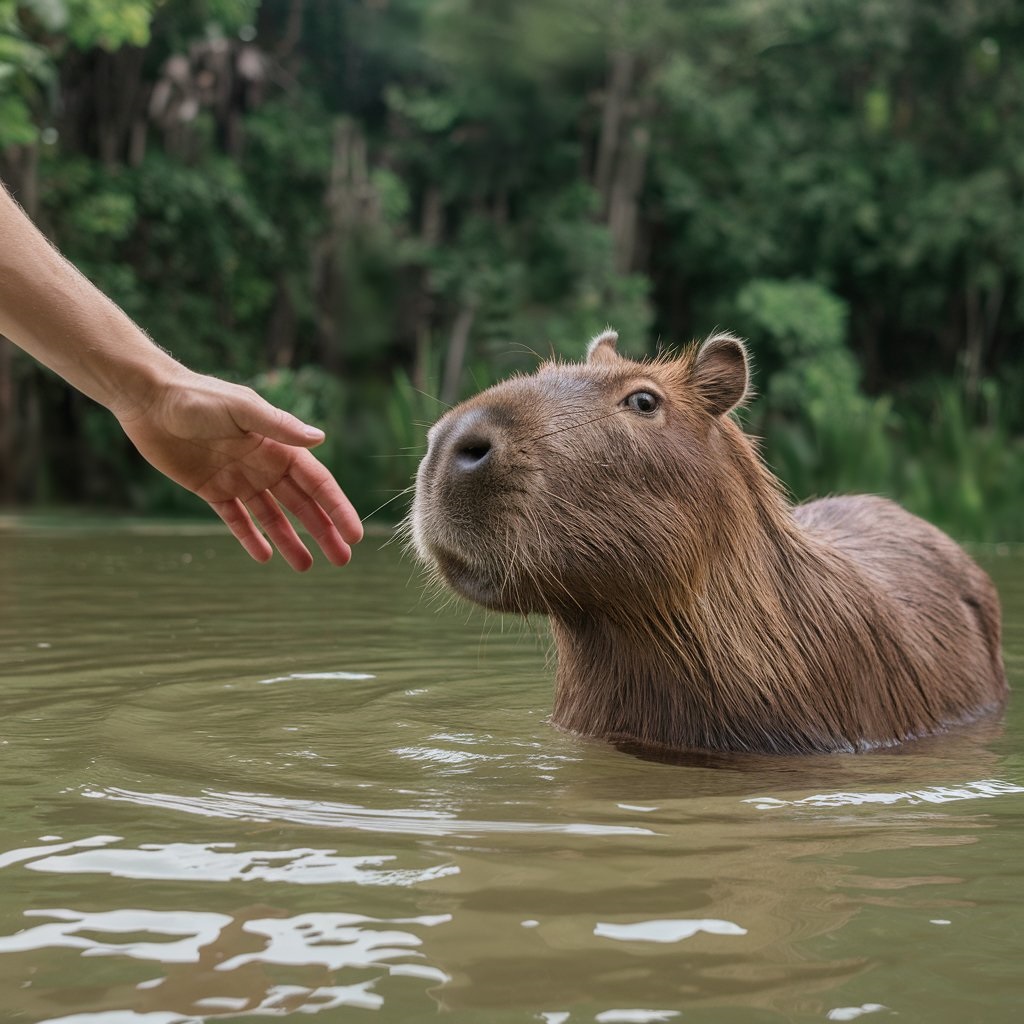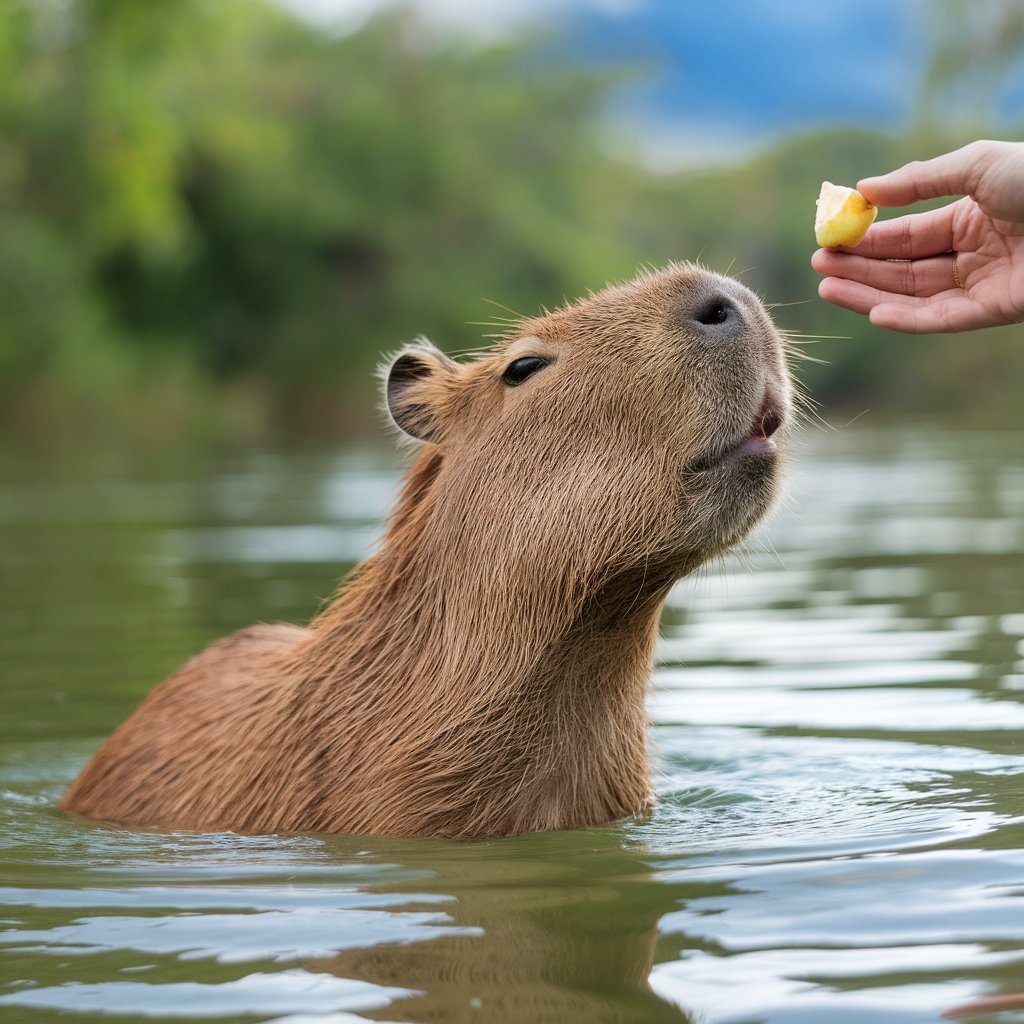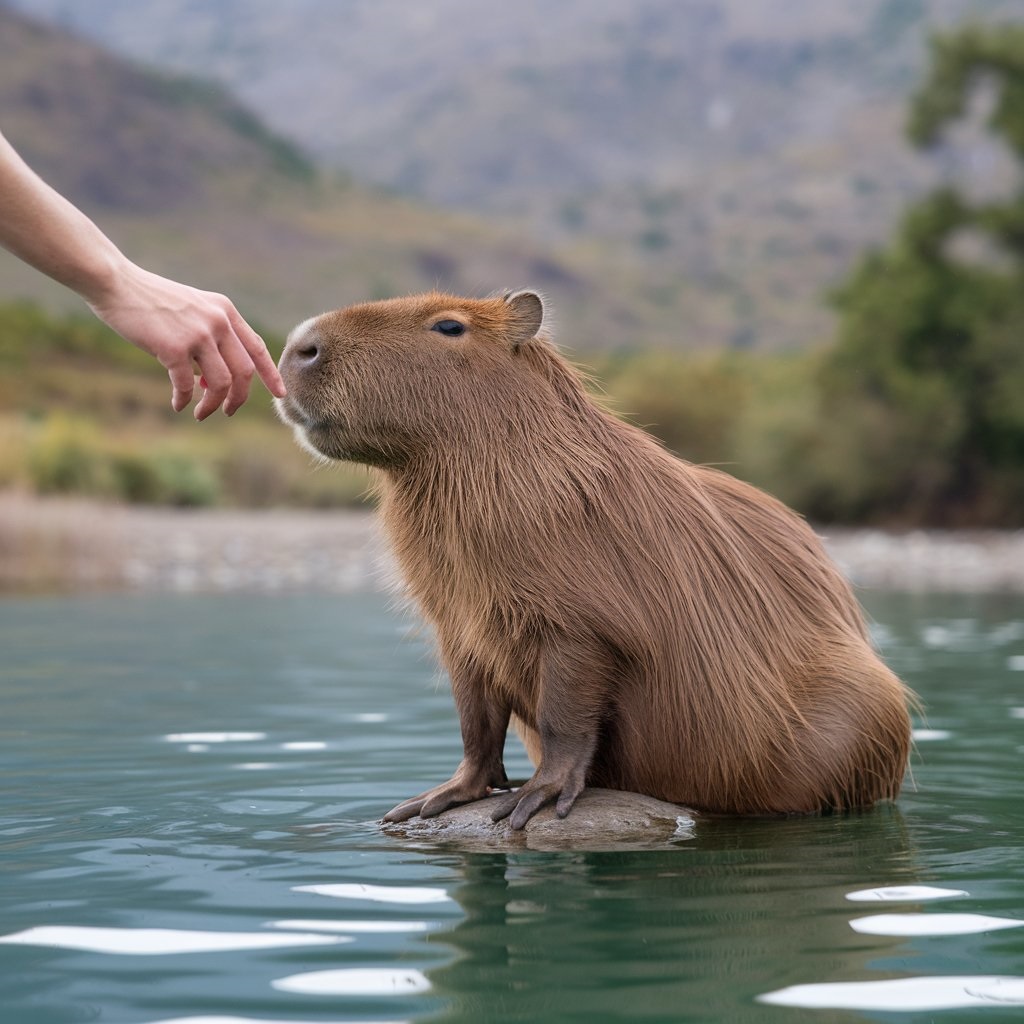Capybaras, often described as nature’s chillest animals, are beloved for their friendly demeanor and unique charm. These gentle giants have become an internet sensation, appearing in viral videos where they interact peacefully with other animals and humans. But despite their calm reputation, a common question arises: Do capybaras attack humans?
The answer is not as simple as a yes or no. While capybaras are generally docile, there are certain scenarios where they might display defensive behavior. This article delves into the natural behavior of capybaras, their interactions with humans, and practical tips for safe encounters. Whether you’re curious about their temperament or considering visiting one of their habitats, this comprehensive guide will help you understand these fascinating creatures better.
Here’s a comprehensive Facts and Figures table summarizing key information from the article:
| Category | Details |
|---|---|
| Scientific Name | Hydrochoerus hydrochaeris |
| Average Weight | 77–146 pounds (35–66 kg) |
| Average Length | 3.5–4.4 feet (106–134 cm) |
| Height at Shoulder | Approximately 20 inches (50 cm) |
| Lifespan | 8–10 years (in captivity) |
| Diet | Herbivorous: grass, aquatic plants, fruit |
| Habitat | Rivers, lakes, marshes, swamps |
| Native Regions | South America: Brazil, Venezuela, Colombia, and surrounding areas |
| Social Group Size | Typically 10–30 individuals |
| Behavioral Traits | Docile, social, flight-oriented when threatened |
| Defensive Mechanisms | Escape into water, occasional biting when cornered |
| Activity Pattern | Crepuscular (active during dawn and dusk) |
| Communication | Whistles, barks, purrs to convey distress, warnings, or contentment |
| Swimming Abilities | Semi-aquatic; can hold breath underwater for up to 5 minutes |
| Known Aggression Cases | Rare, typically caused by stress, cornering, or maternal defense |
| Interactions with Humans | Generally friendly; popular in petting zoos and wildlife attractions |
| Risks to Humans | Bites (rare), zoonotic disease transmission, stress-induced behavior |
| Hot Springs Attraction | Famous capybara hot springs in Japan showcase their relaxed demeanor |
| Predators in Wild | Jaguars, anacondas, caimans, and large birds of prey |
| Popularity | Beloved as exotic pets, therapy animals, and symbols of calm coexistence |
What Are Capybaras?
Capybaras (Hydrochoerus hydrochaeris), the largest rodents in the world, are semi-aquatic mammals native to South America. These unique creatures belong to the same family as guinea pigs, yet they dwarf their relatives in size and adaptability.

Physical Characteristics
Capybaras have barrel-shaped bodies covered in coarse fur that ranges from reddish-brown to grayish-yellow. Adults can grow up to 4 feet long and weigh between 77 and 146 pounds. Their webbed feet make them exceptional swimmers, an essential trait for survival in their natural habitats.
Habitat and Diet
These animals thrive near water sources such as rivers, lakes, swamps, and marshes. Their semi-aquatic lifestyle allows them to escape predators and regulate their body temperature. As herbivores, capybaras consume grasses, aquatic plants, and fruits, spending up to 8 hours a day grazing.
Social Structure
Capybaras are highly social animals that live in groups of 10 to 30 individuals. These groups are led by a dominant male and include females, juveniles, and subordinate males. Their cooperative lifestyle is a key factor in their low levels of aggression.
Do Capybaras Attack Humans?
The short answer is: very rarely. Capybaras are generally non-aggressive, making attacks on humans uncommon. However, as with any animal, their behavior can change depending on circumstances, such as stress, provocation, or health issues.
Why Are Capybara Attacks Rare?
Capybaras lack the territorial aggression seen in many wild animals. Instead of attacking, they usually opt for escape when threatened. This tendency aligns with their status as prey animals, as they are hunted by predators like jaguars, anacondas, and crocodiles.
That said, there are isolated cases where capybaras have bitten humans. These incidents are typically the result of improper handling or misunderstandings of their body language. Learning about their behavior is crucial for safe and positive interactions.
Capybaras’ Natural Behavior
Understanding capybara behavior helps explain why they are generally non-aggressive. These animals are peaceful by nature, preferring to avoid conflict whenever possible. Their behavior is deeply influenced by their social structure, environment, and instincts as prey animals.
Key Aspects of Capybara Behavior
- Social Animals: Capybaras rely on group cooperation for safety and survival. This minimizes internal conflicts and aggression.
- Flight Over Fight: When faced with danger, capybaras will usually retreat into the water, where they can hold their breath for up to five minutes.
- Docility: Capybaras are herbivorous and lack predatory instincts, further reducing their likelihood of attacking.
- Body Language: They communicate through vocalizations and subtle body movements, such as teeth chattering or fur bristling, to indicate discomfort or stress.
Their calm demeanor has earned them a reputation as one of the most peaceful animals, but it’s essential to remember that all animals can display defensive behaviors under certain conditions.
Capybaras in the Wild vs. Captivity
The behavior of capybaras varies depending on their environment. Whether they are in the wild or captivity plays a significant role in how they interact with humans and other animals.
In the Wild
In their natural habitats across South America, capybaras are exposed to predators and environmental challenges. These factors shape their cautious and flight-oriented behavior.
- Habitat Preferences: Found in countries like Brazil, Venezuela, and Colombia, capybaras stay close to water for safety and sustenance.
- Natural Predators: They face threats from large predators such as jaguars and caimans, which reinforces their instinct to avoid conflict.
- Limited Human Interaction: In the wild, capybaras rarely encounter humans, making them less likely to approach.

In Captivity
In zoos, petting zoos, and private collections, capybaras interact more frequently with humans. While this exposure can lead to habituation, it can also cause stress if their needs are not properly met.
- Behavioral Adaptations: Capybaras in captivity may become more tolerant of human presence, but they can still react defensively when overstimulated.
- Overcrowding Stress: Inadequate space or overhandling can lead to signs of discomfort or aggression.
- Unique Experiences: In places like Japan, where capybara hot springs are a popular attraction, these animals have adapted to human observation without showing signs of stress.
Triggers for Aggression in Capybaras
Although capybaras are generally peaceful, certain triggers can provoke defensive behaviors. Understanding these triggers helps prevent negative encounters.
Common Triggers
- Feeling Cornered: Capybaras prefer escape but may react defensively if they feel trapped.
- Maternal Instincts: Mother capybaras can become temporarily aggressive to protect their young.
- Improper Handling: Rough or invasive interactions can cause stress and provoke bites or scratches.
- Pain or Illness: Capybaras experiencing discomfort may display uncharacteristic aggression.
- Environmental Stress: Loud noises, overcrowding, or unfamiliar surroundings can make them anxious.
Recognizing these situations is vital for fostering safe and positive interactions.
Interactions with Humans
Capybaras have gained popularity for their peaceful interactions with humans, but these encounters require respect and understanding.
Positive Interactions
- Petting Zoos: Capybaras are a popular attraction due to their calm nature. Visitors often enjoy feeding or petting them under supervision.
- Wildlife Observation: Watching capybaras in their natural habitat is a serene experience, offering insights into their behavior.
- Therapeutic Benefits: Their gentle demeanor has made capybaras a favorite in animal-assisted therapy programs.
Negative Interactions
Despite their docility, capybaras can react defensively if provoked or mishandled. Instances of biting or scratching are rare but typically stem from stress or improper interaction.
5 Reasons Why Capybaras Rarely Attack Humans
- Naturally Calm Temperament: Capybaras are inherently peaceful and prefer avoiding conflict.
- Flight-Oriented Instincts: As prey animals, their first response to danger is escape, not aggression.
- Non-Predatory Diet: Being herbivores, capybaras lack the aggression associated with carnivorous animals.
- Social Structure: Living in cooperative groups reduces stress and fosters peaceful behavior.
- Adaptability to Humans: Capybaras in captivity often become accustomed to human presence, further lowering aggression levels.

Potential Risks in Human Interaction
While capybaras are generally safe, certain risks should be considered when interacting with them.
Risks and Prevention
| Risk | Cause | Prevention |
|---|---|---|
| Bites or Scratches | Stress or mishandling | Handle gently and avoid provoking. |
| Zoonotic Diseases | Transmission of bacteria or parasites | Wash hands after contact; avoid feeding. |
| Stress to the Animal | Overcrowding or loud environments | Limit interaction time and maintain calm. |
| Overfeeding | Poor diet in captivity | Follow guidelines on feeding. |
How to Safely Interact with Capybaras
Do’s
- Approach capybaras slowly and calmly.
- Observe their body language to ensure they’re comfortable.
- Follow rules and guidelines provided by caretakers in zoos or sanctuaries.
Don’ts
- Avoid cornering or chasing capybaras.
- Do not feed them unless permitted.
- Steer clear of loud noises or sudden movements that may startle them.
Recognizing Body Language
Relaxed capybaras may lay down, graze, or swim calmly. Signs of discomfort include teeth chattering, raised fur, or attempts to escape.

FAQs
1. Can capybaras attack humans?
Capybaras are generally gentle, but their large incisors can cause significant harm if they bite, especially when feeling threatened.
2. Has anyone been attacked by a capybara?
Yes, there are rare incidents, like when a woman was bitten and scratched by a capybara while trying to protect her dog.
3. Are capybaras friendly with humans?
Capybaras are known for their sociable and tolerant nature, often interacting calmly with humans and other animals.
4. Are capybaras aggressive?
Capybaras are not naturally aggressive and typically bite only when provoked or scared, making them generally safe around people.
5. What is the friendliest animal?
Capybaras are often considered one of the friendliest animals, alongside dolphins, due to their social and calm demeanor.
6. Can a capybara be a pet?
Capybaras can be kept as pets but require specific care, companionship, and significant resources to meet their needs.
7. Can I hug a capybara?
While capybaras enjoy gentle strokes and tickles, they do not like being hugged or tightly held.
8. What predator kills capybaras?
Capybaras face threats from predators like jaguars, caimans, and anacondas, with young ones also targeted by ocelots and harpy eagles.
9. Are capybaras safe?
Capybaras are usually safe around humans, but they can defend themselves with their large teeth if they feel provoked or in danger.
10. What is a capybara’s lifespan?
Capybaras live up to 10 years in the wild and can reach 12 years in captivity with proper care.
11. Why don’t crocodiles eat capybaras?
Capybaras’ large size makes them difficult for crocodiles to handle, so crocodiles often target smaller, easier prey.
12. Can capybaras bark?
Yes, capybaras can bark, often using it as a warning signal when sensing potential danger.
13. Do capybaras like being petted?
Capybaras enjoy being gently scratched, often relaxing and even falling asleep when petted in the right spots.
14. How old is the oldest capybara?
In the wild, capybaras typically live up to 10 years, but one captive capybara reached an impressive age of 15.1 years.
15. Do capybaras carry diseases?
Capybaras can host ticks that carry rickettsii and are known to transmit diseases like rabies, salmonella, and toxoplasmosis.
16. Can capybaras love humans?
Capybaras are highly social animals and can form bonds with humans, often showing affection by playing and snuggling.
17. Are capybaras in danger?
While not currently endangered, capybaras face threats from habitat destruction, deforestation, and illegal hunting.
18. Why do so many people love capybaras?
Capybaras are adored for their unique mix of cuteness, quirky behavior, and ability to interact peacefully with various animals.
19. Why is the capybara called a water pig?
The name comes from their love for water and their scientific name, Hydrochoerus, meaning “water hog,” though they’re rodents, not pigs.
20. Do capybaras get angry?
Aggression is rare, but adult males occasionally display aggressive behavior, particularly within social group interactions.
Final Verdict
So, do capybaras attack humans? The answer is that it’s highly unlikely. Capybaras are calm, social animals with a natural preference for avoiding conflict. However, like any animal, they may display defensive behaviors if provoked or stressed. By respecting their boundaries and understanding their needs, you can enjoy safe and enriching interactions with these gentle giants.
Whether you encounter them in the wild, at a petting zoo, or in a relaxing Japanese hot spring, capybaras serve as a reminder of the harmony that can exist between humans and wildlife.
“The capybara teaches us that peace and coexistence can thrive in the simplest moments of connection.”
Read more knowledgeable blogs on Flowy Magazine

James Clair is a passionate writer and researcher with a deep fascination for animal behavior and its intricate connection to human life. With a background in [relevant field of study, e.g., zoology, psychology, ethology], James has spent years studying the natural world, focusing on how animals’ actions and instincts impact human emotions, behavior, and society.
His expertise in [specific topics or regions of focus, e.g., canine psychology, animal communication, wildlife conservation] has led to numerous published works and collaborations with renowned researchers and institutions. Through his work at Flawy Magazine, James aims to bridge the gap between scientific research and public understanding, offering insightful, accessible articles that explore the complex relationship between humans and animals.
When he’s not writing, James enjoys [personal hobbies or interests, e.g., hiking in nature, volunteering at animal shelters, photography] and is an advocate for [cause or charity related to animals or conservation]. His mission is to inspire readers to see animals not just as companions or creatures of the wild, but as beings whose behavior holds valuable lessons for us all.









